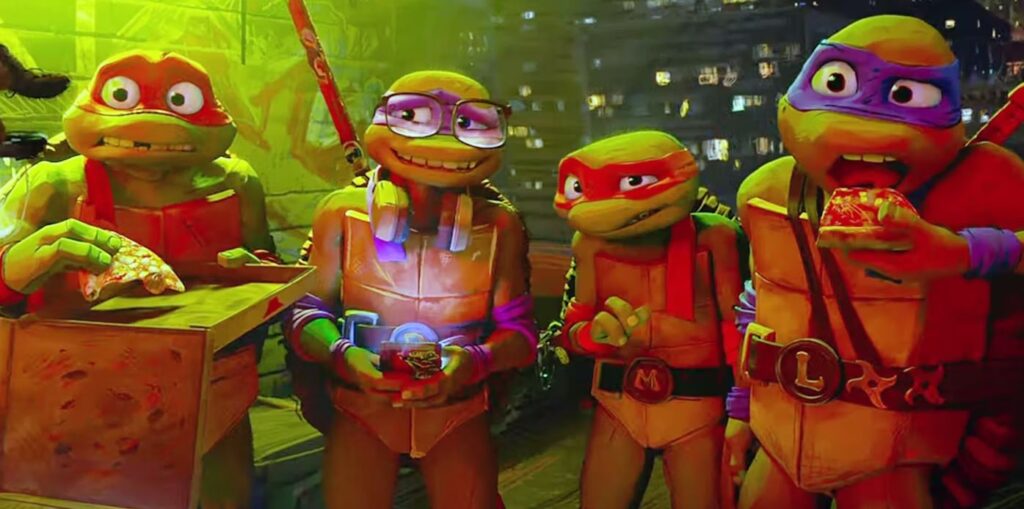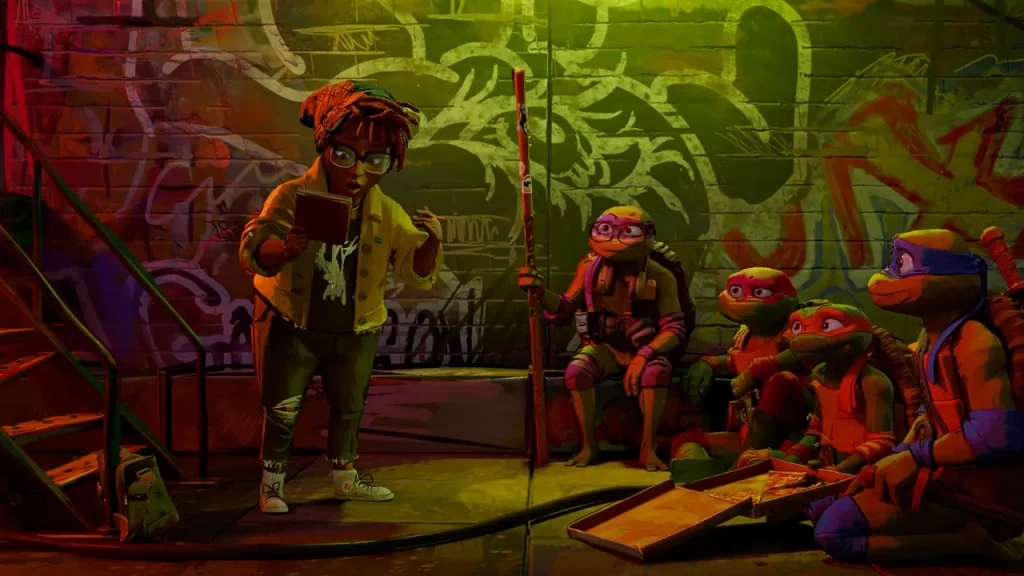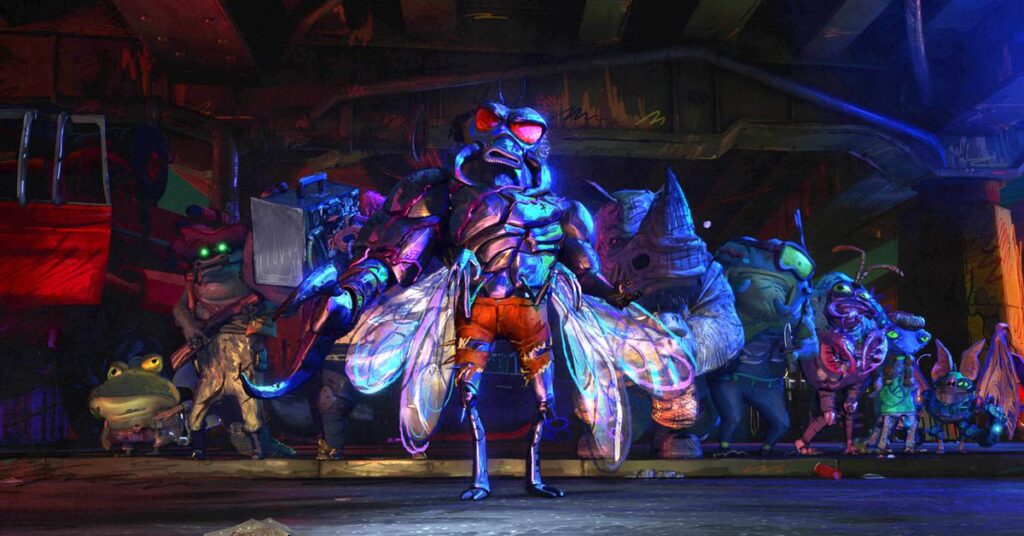
The success of the Spider-Verse pictures has ushered in a new style of animation that doesn’t yet have a name. Where the computerized creations of Pixar and its ilk exhibit hyper-realistic detail and punctilious precision, this burgeoning technique is playfully imperfect and openly fantastical. Rather than attempting to mimic the look of live-action cinema, it leans into its artifice, emphasizing its cartoonish quality through blurred edges, exaggerated features, and chaotic motion. The goal is to approximate the childhood experience of reading a comic book—not so much the literal sense of integrating thought bubbles and splash panels, but the more youthful wonderment of entering a world of obvious invention and boundless possibility.
Teenage Mutant Ninja Turtles: Mutant Mayhem is the latest entrant in this subgenre, and its aesthetic is successful insofar as it’s notable. The movie looks like… well, it looks like something. It’s nowhere near as cleverly designed or rapturously conceived as Across the Spider-Verse; its colors can be muddy, and its action sequences are generally incoherent. But it at least possesses a visual identity—a degree of pictorial flair—that distinguishes it from other animated productions aimed toward younger audiences. It has character.

It also has characters, which is where the problems arise. My fellow Xennials will surely be familiar with these heroes: four giant anthropomorphized tortoises, each named for an Italian Renaissance master, and each wearing a uniquely colored mask. The primary selling point of any Ninja Turtles movie, aside from cashing in on boyhood nostalgia, is the opportunity to watch these goofballs razz each other with brotherly cheer. But while Mutant Mayhem includes plenty of putative jokes, it doesn’t do much to flesh out its foursome, or even differentiate them. The only one with any real personality is Leonardo (voiced by Nicolas Cantu), the dopey leader whose constant earnestness makes him a target of ridicule for his more frivolous siblings. The others are vaguely defined by a single trait. Raphael (Brady Noon) has rage issues. Donatello (Micah Abbey) wears glasses. Michelangelo (Shamon Brown Jr.) likes improv. Yes, and?
It’s odd that the movie’s humor is so feeble—seriously, there’s a runner about the turtles’ fear of getting milked—given its behind-the-scenes pedigree. As with most animated features, quite a few people are involved in Mutant Mayhem, but its dominant voice belongs to Seth Rogen, who co-wrote the screenplay with his best bud Evan Goldberg (along with three others). Former valedictorian of the Judd Apatow school of comedy, Rogen seems like a natural fit for a hangout joint in which four bros trade insults, skip curfew, and eat pizza. Yet the story’s pace is too frantic for it to settle into a comfortable comic rhythm, and the script spends far too much time hammering stale material, as in how our blue-masked turtle’s name could be divided into the silly combination, “Leo Nardo.”

As you might expect from the title’s penultimate word, the movie’s storyline recalls the X-Men pictures, with their dueling tribes of mutant warriors. Our eager young turtles, who are of course supervised by a giant rat named Splinter (Jackie Chan), long to ascend from their sewer and assimilate into metropolitan society. (They’re the rare group of teenagers who actually want to go to high school.) This places them in tension not just with an intolerant populace that instinctively fears what it can’t understand, but with a more militant band of creatures led by Superfly (Ice Cube), a vengeful man-insect who chafes at humanity’s prejudice and is plotting a Magneto-esque scheme to level the playing field. Also in tow is intrepid journalist April O’Neil (Ayo Edebiri), here personified as a wannabe teenage newscaster with anxiety issues that predictably manifest in the form of projectile vomit.
The names in those parentheticals are all recognizable (Edebiri is justifiably rising toward stardom), unlike the unknowns who voice the turtles—a sensible decision that doesn’t distract us from the central character dynamics (such as they are). Beyond that, the call sheet includes a bunch of likable comedians who tend to occupy the same types of movies as Seth Rogen; minor roles have been assigned to luminaries such as Maya Rudolph, John Cena, Rose Byrne, Paul Rudd, and Hannibal Buress. Those are all funny people, but their vocal presence does little to bring definition to Mutant Mayhem’s shapeless batch of secondary characters. (Only Cena’s rhinoceros is visually memorable.)

What is left, then, is the film’s aggressive style, which is eye-catching but also messy. The director, Jeff Rowe, brings some periodic wit to the set pieces, as during a breezy crime-busting montage set to “No Diggity.” But the animators’ bleeding-edge approach to color and line has seeped into the movie’s choreography, which is sloppy and garbled. The action scenes are certainly noisy and large-scaled—the climax makes reference to Godzilla and also recalls the Battle of New York from the first Avengers—but they fail to generate any real momentum or excitement. (Strangely, the same is true of Trent Reznor and Atticus Ross’ overcaffeinated score.)
At one point, Superfly bursts into frame and, in Ice Cube’s inimitable delivery, spits a lyric from an N.W.A. hit. It’s one of the few times I laughed, but it also demonstrates the poverty of Mutant Mayhem’s own ideas, its lack of freshness. The movie is aesthetically intriguing and thematically well-intentioned (it doesn’t feel compelled to underline its progressivism), but that can’t compensate for its flat writing and slapdash execution. Its ending teases a sequel featuring a certain armored archenemy—a reveal that’s all too appropriate. This script needed to be sent to the shredder.
Grade: C
Jeremy Beck is the editor-in-chief of MovieManifesto. He watches more movies and television than he probably should.
